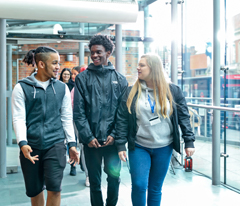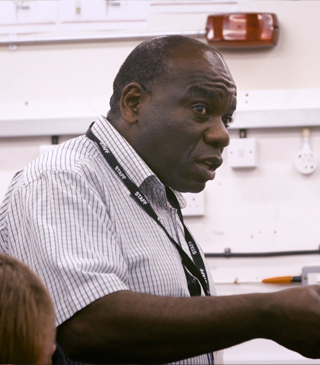History of Carshalton College
Carshalton College, then and now.
Carshalton Technical Institute opened in October 1954 at a cost of £120K for students aged 15-18 years old. Originally built for 1200 students the Institute had two departments, Engineering and General Education and Women's Subjects supported by a team of 11 full-time lecturers and 50 part-time staff.
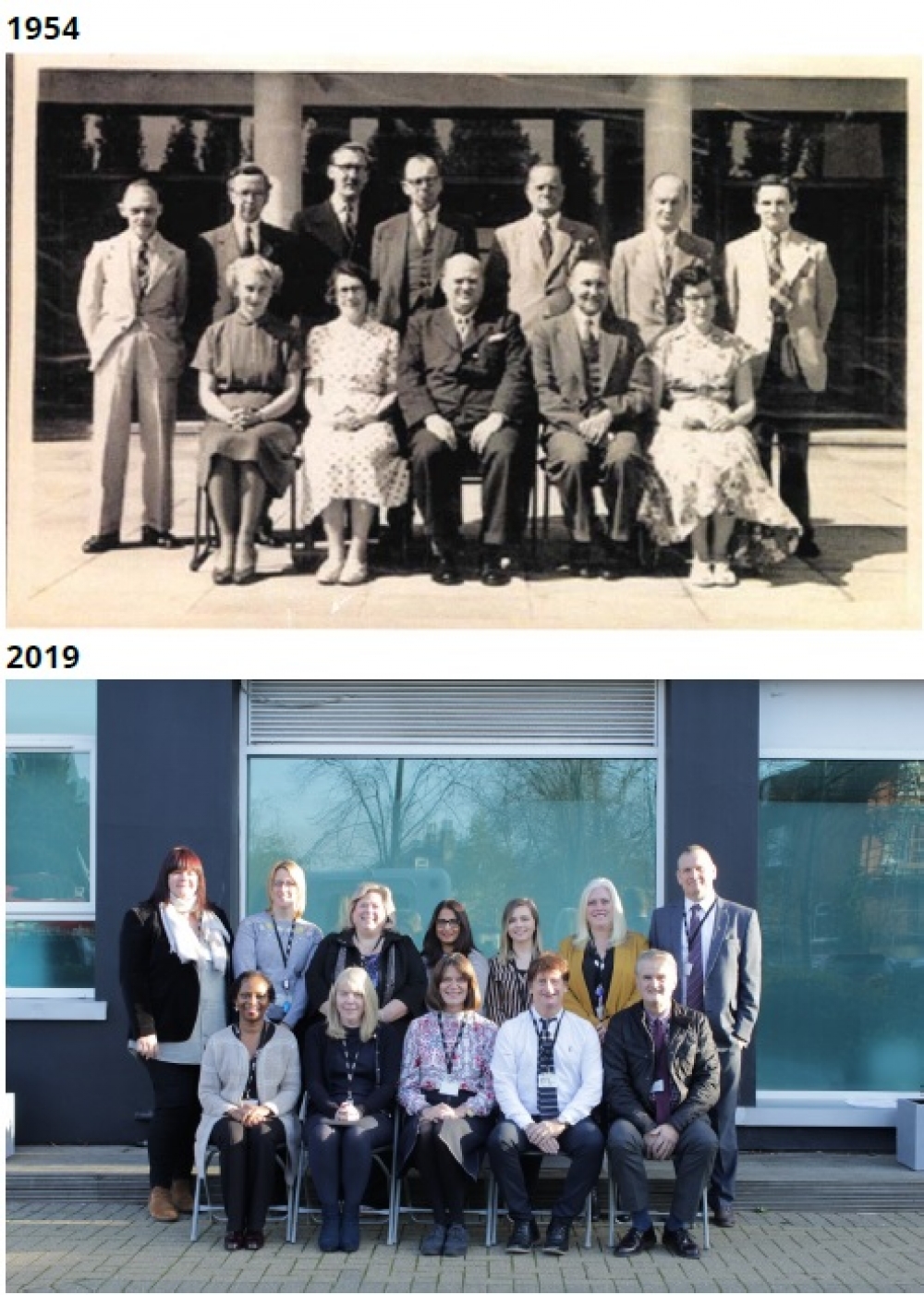
years
The original faculty picture back row (from left to right): Head, Croft, Davis, Weller, Taylor, Bennet, and Savage. Front row: Miss Appleyard, Ms Dolan, Mr Williams (Principal), Smith, Miss Cameron.
Some of our faculty now, back row (from left to right): Anna Johnson, Nicola Jenner, Anne Rule, Pratibha Patel, Jodie Moore, Nicola Laver, and Steve Miller. Front row: Winsome Aldred, Julie Percival, Sharon Muncie, Nigel Powell and Steve Dixon.
Due to an enormous demand for Further Education, the College was extended in 1960 at a cost of £136K doubling the size of facilities.
The 1960s saw the development of "block release" training schemes the ancestors of today’s Apprenticeship programmes. Students would work while coming to the Institute for one day of training per week. Almost 65 years later, similar schemes still provide young people with access to Further Education.
1970 saw the opening of a £287K extension. The extension was officially opened by Sir Barnes Wallis, the wartime developer of the bouncing bombs. The extension included a new mechanical engineering block, a communal block, which provided a refectory library and student common room and several classrooms as well as a language laboratory. The extension doubled the size of the college to accommodate the 3000 students who attended the college, of which 450 were enrolled on full-time courses.
More recently, our Technology, Engineering and Construction (TEC) Centre, opened in June 2016, a £10million investment to create an amazing learning space.
The TEC Centre was the result of a large construction project to open a modern facility using state of the art sustainable technologies. It consolidates the construction and motor vehicle curriculum areas into one single central location for over 900 students. This striking modern building provides state of the art workshops to deliver the bricklaying, carpentry, electrical, motor vehicle, plastering and plumbing lessons.
Carshalton College is now part of the South Thames Colleges Group, which includes Merton College, Kingston College and South Thames College. Carshalton College is recognised for its strong local presence and its thriving vocational curriculum, especially in construction and creative industry courses.
History of Kingston College
Located in South West London, close to the River Thames, Kingston College provides students with a friendly and stimulating environment in which to gain qualifications. Some 3,000 full time and over 4,000 part time students currently benefit from its professional approach to learning. Hardly surprising, therefore, is the rate of progression to higher education. Each year over 500 Kingston College students leave to become undergraduates at British Universities. In addition, over 350 students study at the College on Higher Education courses.
The origins of this success go back to 1899, when the Royal Borough of Kingston upon Thames built Science and Art Schools and a Technical Institute on the present main site of the College in Kingston Hall Road. The Victorian home of Kingston Technical College (as the institution was then known) survived until the 1960s, when major reconstruction work followed a local reorganisation of further and higher education.
In 1962 Kingston Technical College split into the present college of further education and a college of technology, now Kingston University. Because Kingston College and Kingston University have this common heritage, there remains a strong bond between them today which works to the benefit of students. Jointly run courses and close staff relations ensure that a ladder of educational opportunity is available for both full time and part time students from post-GCSE to first degree levels, and beyond. So, as to respond to growing student demand, Kingston College has over the past few years broadened the range of courses on offer to keep the curriculum abreast of new technology.
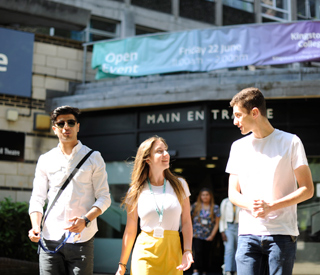
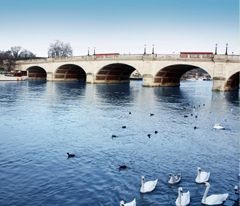
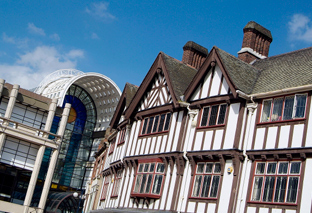

History of South Thames College
There has been an educational establishment on our Wandsworth site in south west London for more than 100 years.
It was founded in 1895, funded by a tax on whiskey! Students had to pay what was then a substantial fee of £1 a term for day classes. There were around 500 students studying there, a large number for those times.
1910-11 College regulations stated that "...each boy must wear the school cap or straw hat; he must also provide himself with a satchel, gymnasium shoes and a swimming costume." Apparently, the caps came in different colours depending on what "House" the student belonged to and, according to one student in 1930, the colours used to run in the rain, staining the students' faces blue, red, green or yellow.
Today, over 21,000 students are enrolled at South Thames College, and government funded courses like BTEC Nationals and A-levels are free for 16-19 year olds.
In 2009, the College merged with Merton College, another thriving education establishment in South West London.
Interestingly, while many things have changed dramatically over the last 100+ years, the focus of what is now South Thames College has not.
In 1895, students were enrolled on 'Trade Classes' designed to train and, maximise the potential of, people looking for skilled work, including carpentry, brickwork, plumbing and hygiene.
Today our vocational courses are still designed to give excellent training and maximise the potential of students looking for skills. These still include carpentry, brickwork, plumbing, and hygiene, but we have expanded into many other areas too.
South Thames College over the years
- 1895 Wandsworth Technical Institute was founded on the Wandsworth High Street site, replacing 'The Parsonage'
- 1900 More than 1,000 students enrolled on courses at the Institute
- 1926 The present buildings on the High Street were completed; they were later awarded a Grade II listing
1940s - During World War II our College was used to train men and women in a variety of skills and occupations that were important to the war effort, for example radar
- 1955 Our new 'South Block' was completed to complement the existing buildings
- 1974 Wandsworth Technical Institute merged with Putney College of Further Education (on Putney Hill)
- 2000 Government Minister Malcolm Wicks opened our Tooting Centre - a new building with state-of-the-art facilities next to Tooting Broadway tube station
- 2000 We completed the refurbishment of our Roehampton Centre which now offers a Learning Centre, IT facilities, cafe, Beauty Therapy suite and Childcare provision
- 2005 We added a new frontage to the Grade II Listed building in Wandsworth High Street, designed to be compliant with the Disability Discrimination Act (DDA). Later in the year we won an Access Award at the Wandsworth Council Design Awards
- 2006 We start development work, including the demolition of the South Block dating from 1955, which will result in a new learning facility at the Wandsworth Campus. As part of the building is listed, we have to use a clever design to connect the old and new buildings
- 2009 We open for business in the redeveloped Wandsworth campus
- 2009 The complete redeveloped Wandsworth Campus is opened officially
- 2009 Merton College merges with South Thames so between them there are now five sites across two boroughs with campuses in Balham, Merton, Roehampton, Tooting and Wandsworth
- 2013 Based at the Merton Campus, our flagship Hospitality and Catering Academy opens. It includes Taste, a commercial restaurant open to all and run by the students as part of their studies to provide valuable workplace experience
- 2013 Aurora, our non-residential centre for 16-25 year olds with autistic spectrum disorder and complex needs, opens. Here a dedicated team delivers individualised learning pathways for these young adults

